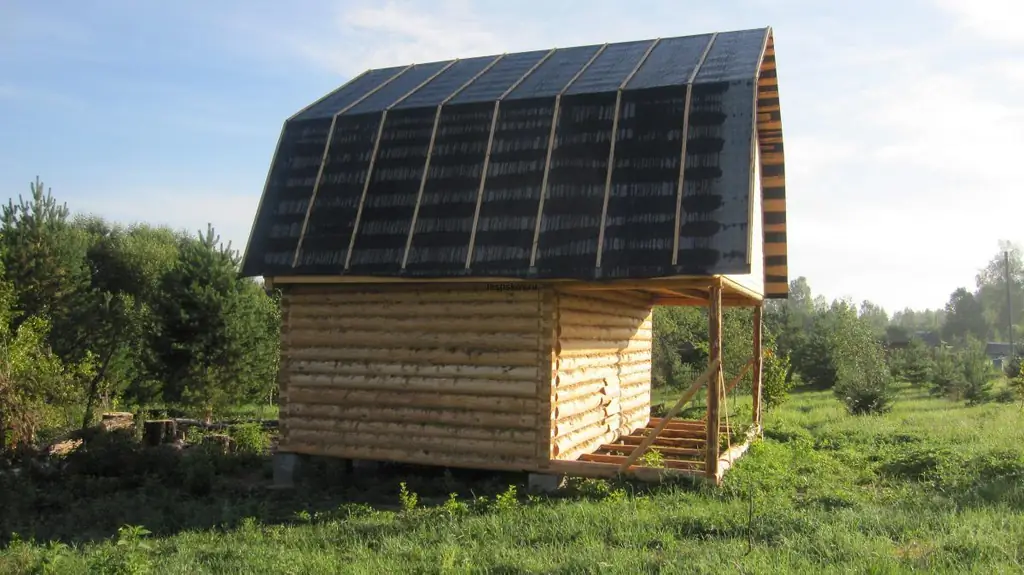
Table of contents:
- Author Bailey Albertson [email protected].
- Public 2023-12-17 12:53.
- Last modified 2025-06-01 07:32.
Light coverage: from A to Z about roofing felt on the roof

The low price, ease of installation and long service life have made roofing material an irreplaceable roofing material. This soft coating has undergone a number of modifications, so it began to be used in all operating conditions. Roofing material differs from other materials and requires a special approach to laying on the roof.
Content
-
1 Roofing from roofing material: basic concepts
- 1.1 Description of roofing felt
-
1.2 Manufacturers of roofing board
1.2.1 Table: list of manufacturers
- 1.3 Roofing device made of roofing material
-
1.4 Varieties
1.4.1 Table: characteristics of different brands
- 2 Calculation of the amount of material
-
3 Installation of roofing felt
- 3.1 Laying tool
- 3.2 Nuances of mounting soft material
- 3.3 Video: how to cover the roof with roofing material
- 3.4 Laying errors
-
4 Features of operation
- 4.1 Service life of roofing material
-
4.2 Repair of soft roofs
4.2.1 Video: repair of roofing material
Roofing from roofing material: basic concepts
The second "name" of roofing material is "roofing cardboard". The additional name is not taken out of thin air - roofing felt is famous for its softness, flexibility and wide operational capabilities.
Description of roofing felt
Roofing material is a material that goes through three stages in the manufacturing process: filling roofing cardboard with low-melting petroleum bitumen, processing with refractory compounds and sprinkling with a protective agent on both sides. The coating created in this way is rolled up.

The cardboard base of roofing material is treated with bitumen and special dressing on each side
Roofing material is used to cover both flat and pitched roofs. But for the most part they are used when it is necessary to protect the foundation from moisture, as well as the lower or upper layer of the roof.
The undoubted advantages of roofing material are:
- light weight;
- long service life (up to 15 years);
- application regardless of the degree of inclination and roof configuration;
- resistance to dampness;
- unrivaled durability.

Roofing material in rolls as a roofing covering is lightweight and is used without restrictions
To the main disadvantage of roofing material, builders attribute a high risk of ignition. Still, this material is produced on the basis of petroleum products.
Roofing board manufacturers
One manufacturer of roofing material has achieved the greatest fame - the plant of roofing and waterproofing materials "Technonikol". However, in addition to it, more than ten Russian companies offer soft and flexible material.
Table: list of manufacturers
| Manufacturer | Address |
| LLC "Cardboard and Packaging" | Ufa |
| LLC "Kuzbass SCARABEY" | Kemerovo, pos. Pre-factory |
| JV OJSC "Roof" | Republic of Belarus, Osipovichi |
| "Nicole-pack" | Moscow city |
| Nizhny Novgorod Cardboard and Roofing Plant | Nizhny Novgorod |
| Ryazan Cardboard-Roofing Plant CJSC | Ryazan |
| LLC "LesBumService" | St. Petersburg |
| CJSC "Soft roof" | Samara |
| Cheremkhovsky Cardboard and Roofing Plant | Irkutsk |
| Kemerovo soft roof plant | Kemerovo |
| CJSC "Roof" | Murom |
| Khabarovsk Cardboard and Roofing Plant | Khabarovsk |
| Factory of roofing and waterproofing materials "Technonikol" | Vyborg |
| JSC Polimerkrovlya | Smolensk |
Roofing device made of roofing material
The simplest version of a roofing material roof is a structure of several layers: boards laid along the ridge, and then across, and two sheets of soft material.

Two floorings are made for ruburoid: working and protective
Varieties
Roofing roofing felt is classified into 4 types:
- ordinary roofing felt in rolls (glassine) - a material in which the cardboard base is impregnated with butum, supplemented with a coating composition and sprinkled with a protective agent;
- welded roofing material (rubemast) - a material similar in its characteristics to standard roofing material, but featuring a simpler laying technology;
- roofing felt based on synthetics or fiberglass, capable of serving for 12-15 years, that is, longer than material based on cardboard;
- surfaced "euroruberoid" - a new generation roofing coating with a high content of bitumen and polymers, resistant to moisture and extending the service life of the material up to 25 years.
Roofing material of the first two types can be marked with some letters:
- "R" - the sign at the beginning of the marking and referring to the name of the material;
- "K", "P" or "E" - a symbol located in the second position in the marking and indicating the purpose of the material (roofing, lining or elastic, respectively);
- "K", "M", "H" or "P" - the letter that is displayed in the third line and indicates the used dressing (coarse-grained, fine-grained, scaly mica or dusty);
- "O" - a sign indicated if necessary to note that the material is sprinkled on only one side.

The first in the marking of roofing material are letters that provide information on the purpose and composition of the material
After a few letters and a dash in the marking, the weight of the cardboard is put down in grams per 1 m². The higher the specified figure, the higher the density of roofing material, which, in turn, affects the quality and service life of the roofing.
Self-adhesive roofing felt deserves special consideration, which is glued to the roof under the influence of direct sunlight. This material manufacturing technology speeds up installation work and saves on construction raw materials.

Self-adhesive roofing felt adheres to the base of the roof without effort on the part of the builder
The main components of roofing material are bitumen, which turn into fragile substances at low temperatures. Therefore, it is not always appropriate to use roofing material in areas with a cold climate. True, some manufacturers remove this obstacle: they introduce modified polymers into the roofing material, which lower the fragility limit of the material at temperatures up to 50 ° C.
Table: characteristics of various brands
| Roofing material brand | Appointment | Cardboard grade | Sprinkling | Roll area, m². |
| Roofing material lining with dusty dressing | ||||
| RPP-300 | For the top layer of roofing carpet | 300 | Dusty on both sides | 20 ± 0.5 |
| Roofing material lining elastic with dust-like dusting | ||||
| RPE-300 | For the bottom layer of roofing carpet in the Far North | 300 | Dusty on both sides | 20 ± 0.5 |
| Roofing felt roofing with coarse-grained dressing | ||||
| RKK-400 | For the top layer of roofing carpet | 400 | Coarse on the front side and dusty on the underside of the web | 10 ± 0.5 |
| RKK-350 | 350 | |||
| Roofing felt roofing with flake dressing | ||||
| RKCH-350 | For the top layer of roofing carpet | 350 | Scaly on the front side and dusty on the underside of the blade | 15 ± 0.5 |
| Roofing felt roofing with dusty dressing | ||||
| RCP-350 | For the top layer of roofing carpet with a protective layer | 350 | Dusty on both sides | 15 ± 0.5 |
| Roofing felt roofing with colored mineral dressing | ||||
| RC-400 | For upper layers of roofing carpet in southern areas | 400 | Colored dusting on the front side and fine-grained on the underside of the blade | 20 ± 0.5 |
Calculation of the amount of material
How much roll material is needed for the roof, they find out as follows:
- The roof area is calculated in square meters, that is, the length of the slope is multiplied by the width. If the roof has several planes, then first determine the area of one slope, and then the other. The resulting numbers are summed up.
- Find the number of squares. For this, the roof slope is measured in sections of 10 m² or the total roof area is divided by 10.
- They calculate how many rolls of material will go to the roof covering. Since most often one roll of roofing material is enough for 4 m², the previously calculated number of squares is divided by 4.
- Based on the degree of slope of the slopes, they determine how many layers of roofing material need to be laid on the roof. If it is inclined by 45, then one layer of material is used, so no additional calculations are made. With a lower slope of the roof slope (20-40 degrees), 2 layers of roofing material are placed, which means that the amount of material bundles is doubled. When the angle of inclination of the roof is from 5 to 15 degrees, the slope is covered with four layers of canvas, which means multiplying the number of rolls by 4.

A roof sloped by 5-15 degrees must be covered with four layers of roofing material
Installation of roofing felt
If you are going to lay soft roll material on the roof, you need to prepare a special tool and thoroughly study the rules for laying roofing material.
Styling tool
The roll material can be spread on the roof using three technologies using such devices as:
- a hammer (or a screwdriver) complete with iron fungi, slats and nails (or self-tapping screws) fixing pieces of roofing material on the base, laid with an overlap of 15 cm;
-
hand roller, roller, brush with long bristles and mastic, poured into a metal container and carefully applied to the entire surface of the roofing material strips and the area of the seams being created;

Mastic for roofing material It is recommended to take mastic from a large container and mix thoroughly
-
a hand roller, flattening material, and a gas roof burner used to melt the bottom layer of roofing material rolled into a roll, which, when unwound, adheres firmly to the roof.

Heating of roofing material with a burner Operate the burner wearing protective gloves
The nuances of installing soft material
Laying roofing material on the roof is never started immediately. First, the material is given the opportunity to "get used" to the new state: being unrolled, it must lie on the roof for at least one day.

In order for the roofing material to straighten, they must lie on the roof
Installation of roofing roofing material involves the following:
- Heating up bituminous mastic.
- Preparation of a primer - pouring warm bitumen into gasoline.
-
Treatment of every corner of the roof, including cracks and cracks, with bituminous mastic, or (if roofing material is laid by fusing) applying the composition with a layer of 5 mm thick on the edges of the strips of material.

Roofing material laying process Roofing material is glued to a layer of mastic 5 mm thick
- Laying roofing material from bottom to top (with an overlap of 15-20 cm when using a gas burner).
- Fixation of material with a gas burner or other devices, followed by smoothing with a hand roller.
- Laying the second layer of roofing material (with preliminary application of mastic, if the work is carried out without a gas cylinder and rails).
-
Fixing the edges of the roofing felt on the roof with slate nails.

Fastening roofing material To fix the roofing material on the roof to be reliable, it is recommended to drive special nails into the material
- Installation of the next layer of roll material (if necessary).
Video: how to cover the roof with roofing material
youtube.com/watch?v=1YyQ1u_SyNo
Stacking errors
Most often, when installing roofing roofing felt, the following oversights are allowed:
- they buy little material, forgetting that at least 2 layers of roofing material are required to be laid on the roof;
- overheat the soft coating with a gas burner, which is why its quality deteriorates;
- roofing material is laid on a surface that has not been treated with mastic, which leads to poor soldering of the material to the base;
-
do not smooth out the soft roofing with a hand roller, as a result of which air "pockets" are formed between the roof surface and the roofing felt;

Hand roller If you do not walk on the roofing felt with a hand roller, then the adhesion of the material to the surface will be poor
- take on the laying of roll material in rainy and cold weather, which makes the roofing material extremely fragile;
- the roofing sheet is cut into pieces directly during its installation on the roof, which makes the work significantly complicated and delayed;
- when measuring strips of roofing material, they do not leave a small margin (15-20 cm), which results in the inability to fix the material under the base of the roof.
Features of operation
To insure against damage to the roof and even extend the service life of roofing material, it is necessary to visually inspect the roofing sheet from time to time. Damage to the soft material must be identified and repaired without delay, since any small hole in the roofing material tends to grow rapidly in size.
The service life of a roofing material
During the operation of a soft roof in roofing felt, they are usually not disappointed. This material has a relatively long service life, because it is resistant to ultraviolet radiation, water, low or high temperatures and other adverse factors.

Roofing material on the roof will last a long time if it is laid without errors
It is believed that roofing material can function on the roof without problems for 5 years. However, the soft material can easily surpass itself and serve for 30 years. Of course, for this, certain conditions must be met: correct installation and timely repair.
Soft roof repair
Roofing material must be repaired in autumn, when the rains stop, and in late spring.
What exactly will be the operation to restore the soft roofing depends on the scale and nature of the damage
When examining roofing material on the roof, they usually encounter such defects as:
- cracks, which can be eliminated by cleaning and drying the surface and blocking voids in the roofing material, first with mastic, and then with bitumen;
- holes removed by putty after cleaning the material from debris and the old layer of mastic;
- tears in the canvas, which can be hidden behind patches made from pieces of roofing material and smeared with mastic around the edges;
- a through hole, eliminated by creating a cross-shaped notch, bending the resulting corners to the sides, treating the hole with mastic and blocking the hole with two pieces of roofing material (the first is put into the hole, and the second - on it, having previously bend the corners).

Repairing a roofing material roof usually involves applying a patch
If too much mastic gets into damage or patches during the repair of the roofing material, then this small oversight can be corrected by removing the excess composition with a spatula.
Video: roofing repair from roofing material
To cover the roof with roofing material without making stupid mistakes, follow the instructions for installation. Usually, laying soft material on the roof is easy for anyone who knows at least a little about construction.
Recommended:
Roofing From A Profiled Sheet, Including The Features Of Its Design And Operation, Repair, As Well As How To Avoid Mistakes During Installation
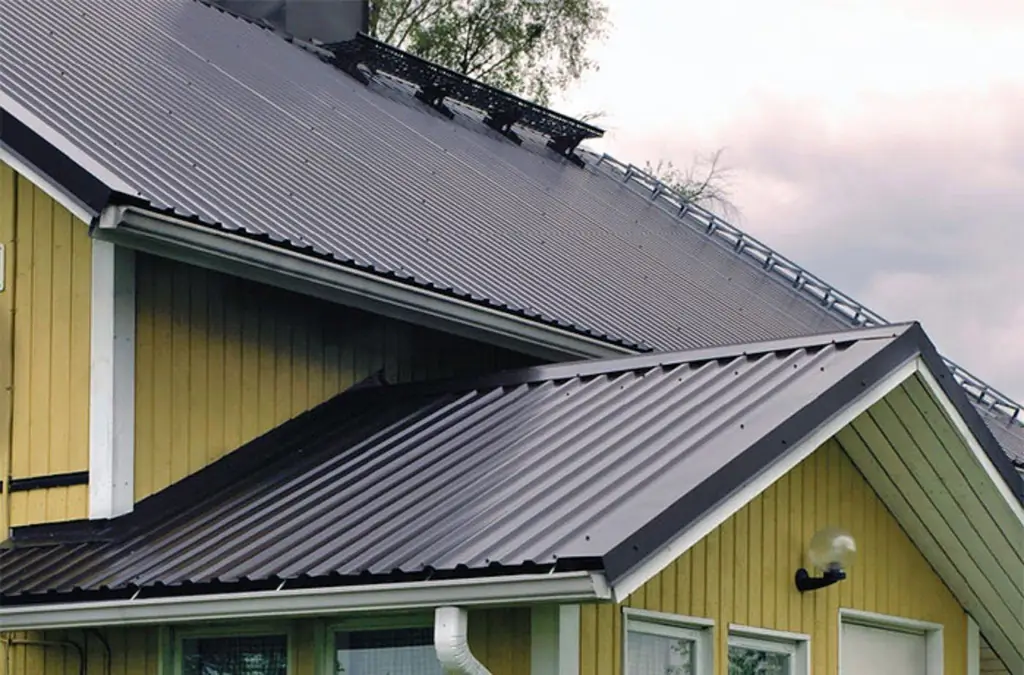
What kind of profiled sheet can be used for the roof. DIY cold and insulated roof device. What mistakes are possible. Features of operation and repair
Polycarbonate Roofing, Including The Features Of Its Construction, Operation And Repair, As Well As How To Avoid Mistakes During Installation
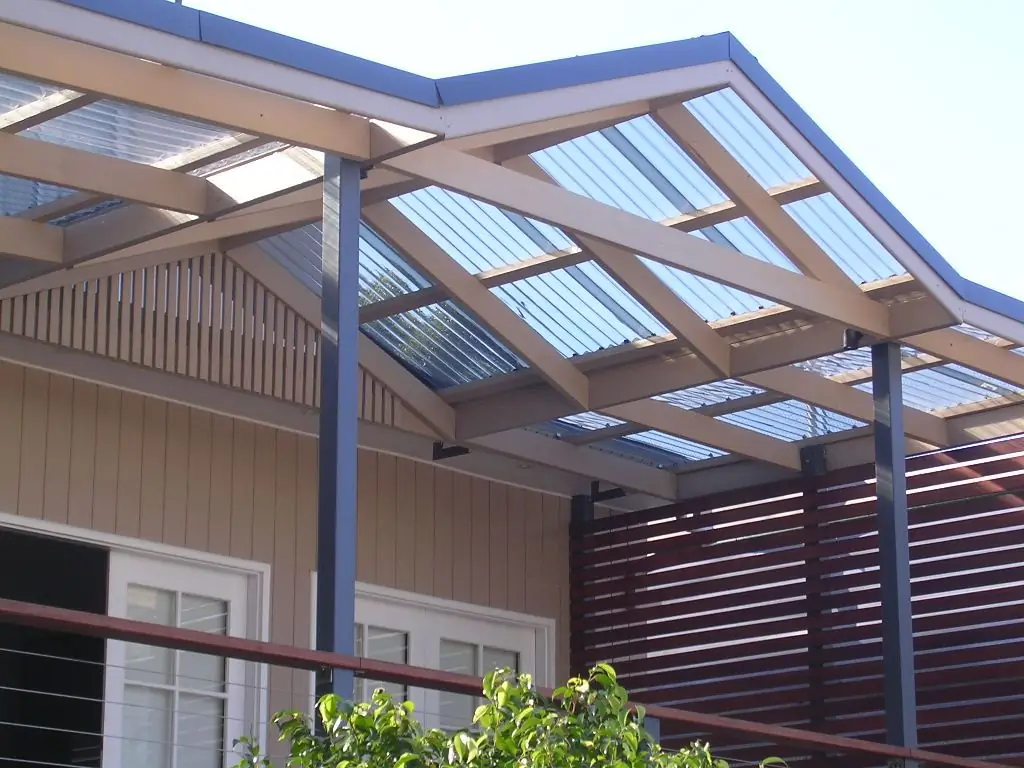
Characteristics of polycarbonate as a roofing material. How to make a polycarbonate roof with your own hands. Features of operation and repair. Photo and video
Roll Roofing, Including The Features Of Its Construction, Operation And Repair, As Well As How To Avoid Mistakes During Installation
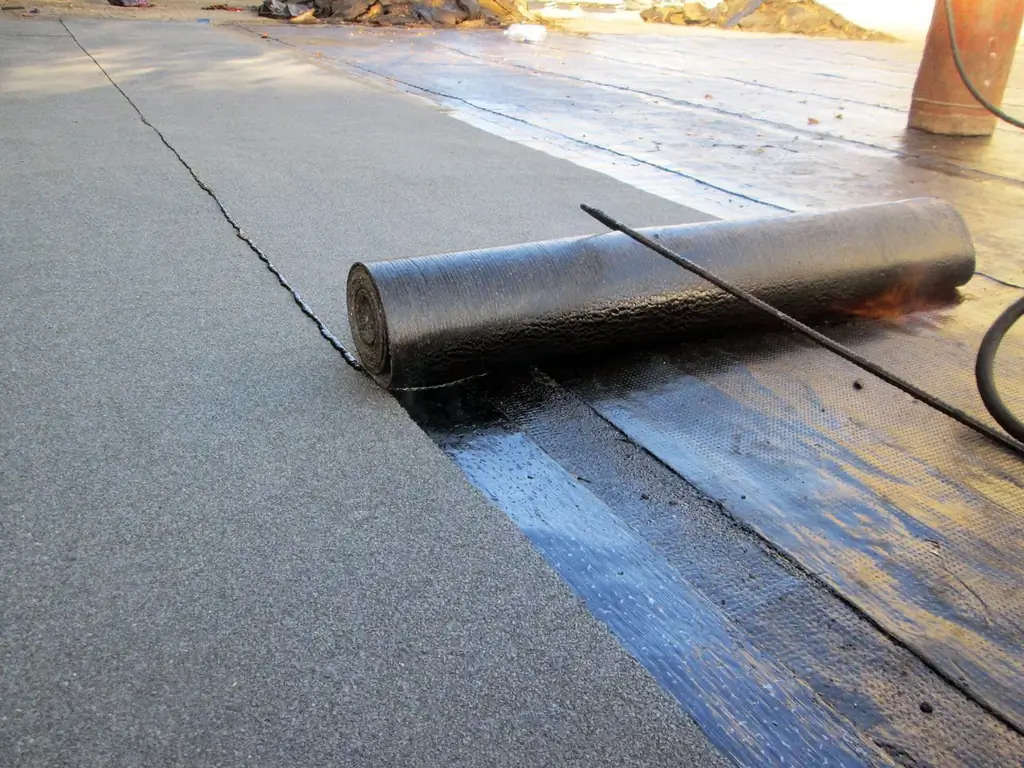
The difference between roll roofing and modern and Soviet counterparts. Can I use roll roofing on a pitched roof? How to install it and when to repair it
Roofing Made Of Corrugated Board, Including The Features Of Its Design And Operation, Repair, As Well As How To Avoid Mistakes During Installation
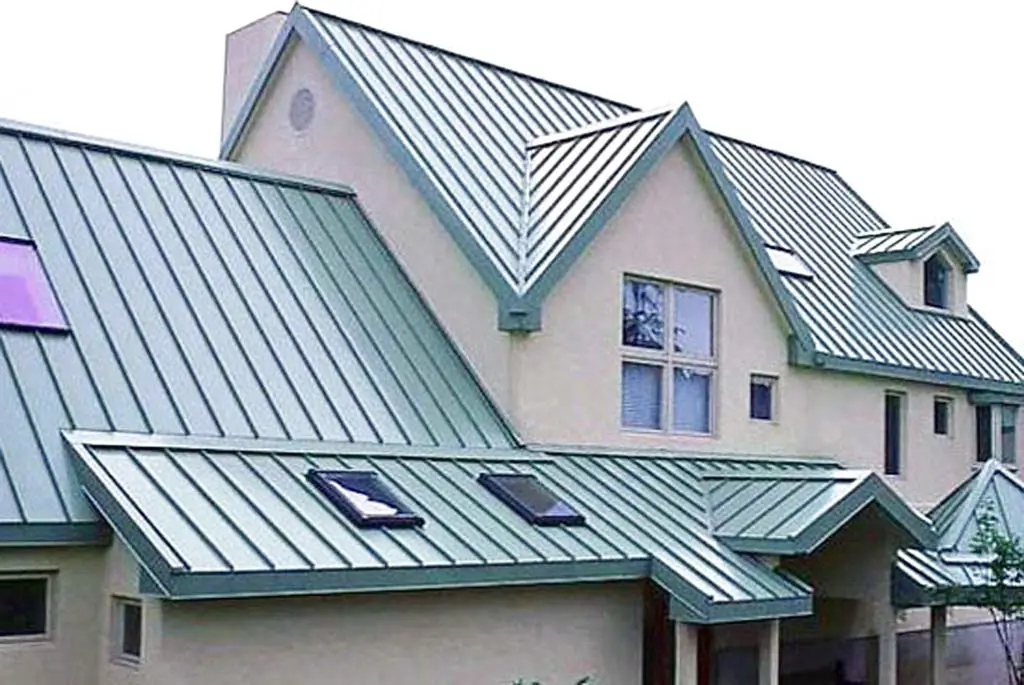
Features and characteristics of corrugated roofing. Types of roofing sheeting. Calculation of the amount of material for the roof. Features of installation and operation
Seam Roofing, Including The Features Of Its Construction, Operation And Repair, As Well As How To Avoid Mistakes During Installation

Features of the design and characteristics of the folded roof. Required tools and installation sequence. Repair and operation of seam roofing
